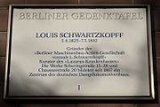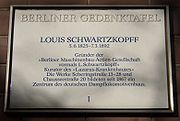
Louis Victor Robert Schwartzkopff
Encyclopedia
Life
Louis Schwartzkopff was born in MagdeburgMagdeburg
Magdeburg , is the largest city and the capital city of the Bundesland of Saxony-Anhalt, Germany. Magdeburg is situated on the Elbe River and was one of the most important medieval cities of Europe....
. Between 1831 and 1842 he attended the grammar school in Magdeburg as well as the trade school there, where he, together with Carl Wilhelm Siemens
Carl Wilhelm Siemens
Carl Wilhelm Siemens was a German born engineer who for most of his life worked in Britain and later became a British subject.-Biography:...
, studied mathematics under Carl’s brother, Werner von Siemens. From 1842 to 1845 Schwartzkopff attended the trade institute (Gewerbeinstitut) founded by Wilhelm Beuth
Christian Peter Wilhelm Beuth
Christian Peter Wilhelm Friedrich Beuth was a Prussian statesman, involved in the Prussian reforms and the main mover in Prussia's industrial renewal....
in Berlin
Berlin
Berlin is the capital city of Germany and is one of the 16 states of Germany. With a population of 3.45 million people, Berlin is Germany's largest city. It is the second most populous city proper and the seventh most populous urban area in the European Union...
. After that he did his practical training at the firm of Borsig, where he got to know August Borsig
August Borsig
Johann Friedrich August Borsig was a German businessman who founded the Borsig-Werke factory.Borsig was born in Breslau , the son of cuirassier and carpenter foreman Johann George Borsig...
personally. Schwartzkopff finished his training with a six-month post as an engine driver on the Berlin-Hamburg Railway
Berlin-Hamburg Railway
The Berlin–Hamburg Railway is a roughly long railway line for passenger, long-distance and goods trains. It was the first high-speed line upgraded in Germany to be capable of handling train speeds of over...
. Between 1847 and 1851 he was the chief mechanical engineer (Maschinenmeister) of the Magdeburg-Wittenberg Railway.
With the support of his family he bought the site at Chausseestrasse 20, which was bordered to the south by Invalidenstrasse and to the east by the Berlin-Stettin Railway. Under the terrain of the latter is the underground S-Bahn station called Nordbahnhof
Berlin Nordbahnhof
Berlin Nordbahnhof is a railway station in the Mitte district of Berlin, Germany. It is served by the Berlin S-Bahn and local bus and tram lines.-History:...
.
On 3 October 1852 he founded, together with the then Berliner Gießereimeister Nitsche
Nitsche
Notable people with the surname Nitsche include:* German psychiatrist Paul Nitsche,* German mathematician Joachim Nitsche....
the Schwartzkopff and Nitsche Iron Foundry & Engineering Works (Eisengießerei and Maschinenfabrik Schwartzkopff and Nitsche) in Berlin, from which the Berliner Maschinenbau AG vorm. L. Schwartzkopff
Berliner Maschinenbau
Berliner Maschinenbau AG was a German manufacturer of locomotives.The factory was founded by Louis Victor Robert Schwartzkopff on 3 October 1852 as Eisengießerei und Maschinen-Fabrik von L. Schwartzkopff in Berlin ....
emerged in 1870. Schwartzkopff wanted above all to expand the engineering works, whilst Nitsche preferred to concentrate on artistic castings. So Schwartzkopff bought Nitsche out in 1853 and from then on ran the firm as the only owner. Until 30 June 1888 he was the general manager of the company, but then pulled out of the firm entirely.

At the end of the 1880s Schwartzkopff was appointed to the Council of State for the Prussian Government (Staatsrat der Preußischen Regierung). On 7 March 1892 he died as the result of a stroke
Stroke
A stroke, previously known medically as a cerebrovascular accident , is the rapidly developing loss of brain function due to disturbance in the blood supply to the brain. This can be due to ischemia caused by blockage , or a hemorrhage...
. During his life Schwartzkopff always held his master, August Borsig, in high esteem.
Schwartzkopff was curator of the Lazarus Hospital. Schwartzkopffstrasse in Berlin-Mitte was named in his honour on 12 March 1889.
He was buried at the Dorotheenstadt cemetery in Berlin.
External links
- www.schwartzkopff-wildau.de - A short biography with a photograph (German).
External links
- There is a relevant English-language forum at Railways of Germany

